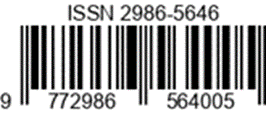Yeni Eliza's Weaving Dance Choreography at the Sari Bunian Art Studio, Andaleh Baruh Bukik District, Tanah Datar District
DOI:
https://doi.org/10.24036/ag.v1i3.31Keywords:
Dance, weaving, Sari Bunian Art StudioAbstract
This article aims to describe and analyze Yeni Eliza's Weaving Dance Choreography at Sari Bunian Art Studio in Tanah Datar Regency. The type of research used is qualitative research with descriptive methods. The research instrument is the researcher himself by using tools such as stationery and recording devices. The types of data are primary data and secondary data, which are collected through literature study, observation, interviews, and documentation study. Data analysis was carried out with the steps of data collection, data reduction, data presentation and conclusion drawing. The results showed that the process of Yeni Eliza's Tenun Dance Choreography was started from idea discovery, exploration, improvisation, and composition. Weaving dance choreography has form and aspect aspects, where the form aspect is divided into motion, floor design, top design, group composition, dancers, music, costumes and properties. The content aspect consists of ideas and atmosphere. It can be concluded that Tenun Dance has choreographic planning based on facts because Tenun Dance begins with a new idea with traditional movements and then formed into new movements.
References
Anisa, R. S. (2020). Kreativitas dan Potensi Generasi Muda Andaleh Baruh Bukik dalam Membangun Nagari Andaleh melalui Seni Pertunjukan Tari. Institut Seni Indonesia Padangpanjang.
Hadi, Y. S. (2012). Koreografi: Bentuk-Teknik-Isi. Dwi-Quantum.
Mikaresti, P., & Mansyur, H. (2022). Pewarisan Budaya Melalui Tari Kreasi Nusantara. Gorga : Jurnal Seni Rupa, 11(1), 147. https://doi.org/10.24114/gr.v11i1.33333
Moleong, Lexy J. 2007. “Metodologi Penelitian Kualitatif Edisi Revisi."
Nur’aini Putri, D. (2023). PAYUANG SARAMPAK DANCE FORM AT SANGGAR LINDANG UREK, EAST PAYAKUMBUH DISTRICT, PAYAKUMBUH CITY BENTUK TARI PAYUANG SARAMPAK DI SANGGAR LINDANG UREK KECAMATAN PAYAKUMBUH TIMUR, KOTA PAYAKUMBUH.
Ratmi, Y., & Nerosti, N. (2021). Tari Rentak Kudo Dari Ritual Panen Ke Hiburan Di Desa Tanjung Sungai Penuh. Jurnal Sendratasik, 10(3), 90–99.
Shaesa, G. N. (2021). Tari Angglang Ayu Di Kepulauan Riau Dikaji Dalam Persfektif Analisis Koreografi. Jurnal Seni Tari, 10(10), 65. http://journal.unnes.ac.id/sju/index.php/jst
Soedarsono, R. M. (1999). Seni dan Pertunjukan Indonesia di Era Globalisasi. Jakarta: Depdiknas.
Sugiyono, D. (2014). Metode penelitian pendidikan.
Sumardjo, J. (2000). Filsafat Seni, Bandung: Penerbit ITB. Tengku Luckman Sinar,(1993). Motif Dan Ornament Melayu, Medan: Lembaga Pembinaan Dan Pengembangan Seni Budaya Melayu.
Triana, W. A., & Juwariyah, A. (2017). Proses Kreatif Penciptaan Tari Sparkiling Surabaya (Studi Kasus Tentang Tahapan Proses Kreatif Penciptaan Koreografi Tari Karya Diastiarni Azhar). Solah: Jurnal Seni Pertunjukan 7(1), 1-13.
Widyastutieningrum, S. R. (2018). Pengantar Koreografi.
Downloads
Published
Issue
Section
License
Copyright (c) 2023 Qorri Aqilla, Herlinda Mansyur

This work is licensed under a Creative Commons Attribution-NonCommercial-ShareAlike 4.0 International License.











